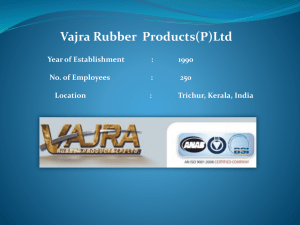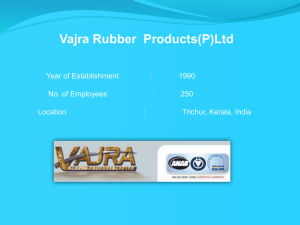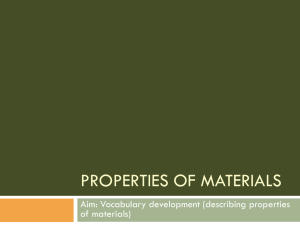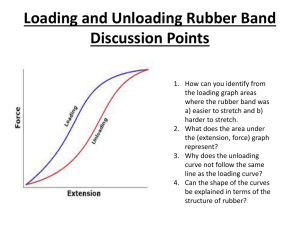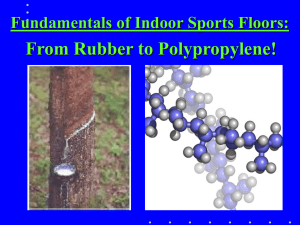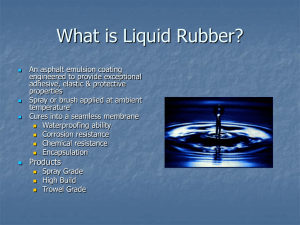4.75 mm Superpave Mix Refinement Study
advertisement
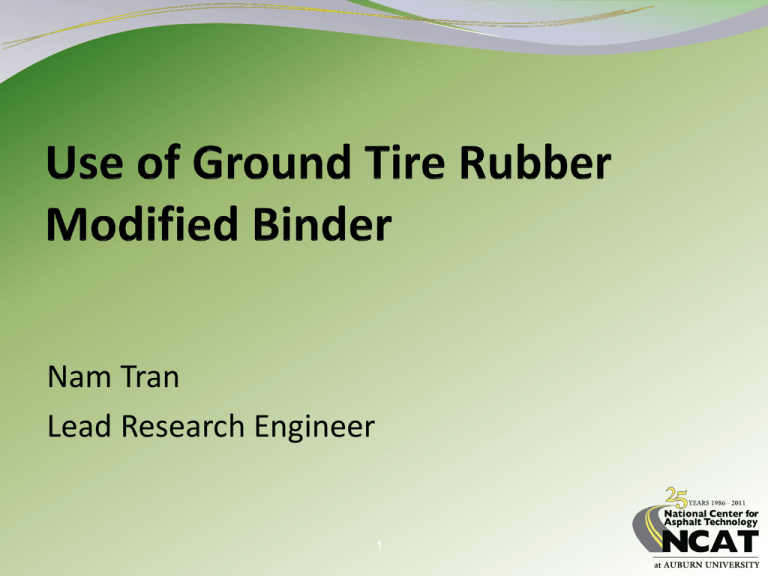
Nam Tran Lead Research Engineer 1 Overview Methods of incorporating GTR Applications of rubber-modified binders Performance of test sections at NCAT test track Questions and concerns 2 Methods 3 Methods Two methods for incorporating GTR into HMA Wet process GTR acts as a binder modifier (up to 20% of total binder) 2 processes: asphalt-rubber and terminal blend Dry process GTR acts as a rubber aggregate (1-3% of aggregate) 4 Asphalt-Rubber > 15% crumb rubber passing #8 or #10 mesh Reacted sufficiently to cause swelling of rubber 2 types of asphalt-rubber binders Type I (used in AZ and TX) 18-20% crumb rubber Type II (used in CA) about 20% rubber 75% tire rubber and 25% natural rubber May include up to 6% heavy aromatic oils Both types blended at elevated temp (>350oF) in low shear system for at least 45 minutes 5 Terminal Blend 5-20% crumb rubber passing #40 or #80 mesh Blended in refinery or stationary asphalt terminal with little or no agitation Can contain polymers All components heated over extended period of time to dissolve rubber particles Used in Arizona, California, Florida, Texas, and several northeastern states 6 Asphalt Rubber vs. Terminal Blend Asphalt Rubber Rubberized Asphalt Terminal Blend 1,500-2,500 centipoises at 375°F, extremely viscous Rubber Pavements Association 300-600 centipoises at 325°F, significantly less viscous than AR 7 Asphalt Rubber vs. Terminal Blend Use more crumb rubber Use less crumb rubber Requires special Does not require special equipment to produce Longer documented history of performance Mostly uses recipe specs Not cost effective in small quantities Cannot be PG graded equipment Shorter documented history Many are proprietary Rubber usage more difficult to document Can be PG graded 8 Applications 9 Applications Asphalt Rubber Concrete Dense-Graded Terminal blend (most effective), Asphalt rubber Asphalt Rubber Concrete Gap-Graded Asphalt rubber (most effective), terminal blend Asphalt Rubber Concrete Open-Graded Asphalt rubber (most effective), terminal blend Stress Absorbing Membrane Interlayer (SAMI) Stress Absorbing Membrane (SAM) 10 Caltrans Reduced Thickness Design Guideline Developed in 1992 based on laboratory and long-term field data (two decades) Uses a deflection based design method Up to 50 % reduction in thickness compared to conventional AC design thickness Over 1000 reduced thickness projects 11 Major Rubber-Modified Asphalt Users California Texas ARSC (AR chip seal) AR Chip Seals SAMI-R AR Underseal (SAMI) RHMA-O CRM-PFC RHMA-G CRM-HMAC RHMA-D Arizona Florida SAM ARMI (SAMI) SAMI GTR modified-OGFC (FC-5) ARFC GTR modified-DGFC ARAC 12 States where Asphalt-Rubber has been used (DOT, Transportation Authority, County or City) New Hampshire Washington Vermont Montana North Dakota Maine Minnesota Oregon Massachusetts New York Idaho Wyoming Nevada South Dakota Nebraska Utah Wisconsin Michigan Iowa Pennsylvania Ohio Illinois Colorado Indiana Missouri Arizona Oklahoma New Mexico Washington, D.C. West Virginia Kansas California Rhode Island Connecticut New Jersey Delaware Kentucky Tennessee Virginia Maryland North Carolina Arkansas Mississippi Georgia Alabama South Carolina Rubber used Texas Alaska Louisiana Not using rubber Florida Hawaii Puerto Rico Rubber Pavements Association Performance of Sections S6 & S7 14 Surface Mixes in Sections S6 & S7 S6 (SBS-modified 76-22) Missouri 12.5 mm coarse Limestone/porph + 2%HL Pb: 5.4% Pbe: 4.5% Va: 4.5% VMA: 14.8% Field Density: 93.1% Thickness: 1.9 in. S7 (GTR-modified 76-22) Missouri 12.5 mm coarse Limestone/porph + 2%HL Pb: 6.0% Pbe: 5.1% Va: 3.3% VMA: 15% Field Density: 93% Thickness: 1.7 in. 15 Laboratory Testing Binder testing Performance grading Multiple-Stress Creep-Recovery (MSCR) test Mixture testing Moisture susceptibility -- TSR (AASHTO T 283) Mixture stiffness – E* (AASHTO TP 79, PP 61) Rutting resistance – APA (TP 63), Hamburg, Fn Cracking – IDT and Energy Ratio 16 Binders S6 S7 SBS-modified PG 76-22 GTR-modified 76-22 Terminal blended Proprietary True grade: 76.6-26.3 M 320: 76-22 True grade: 81.7-25 M 320: 76-22 17 Moisture Susceptibility (TSR) S6 (SBS-modified 76-22) TSR 148 . 1 S7 (GTR-modified 76-22) 0 . 86 TSR 171 . 4 203 . 3 222 . 0 18 0 . 92 Mixture Stiffness (E*) 10000 |E*|, ksi 1000 100 10 -6.00 -4.00 -2.00 0.00 2.00 4.00 6.00 Log Frequency, Hz S6-Confined S7-Confined 19 S6-Unconfined S7-Unconfined Rutting Resistance (APA, o 64 C) Rut Depth (mm) 2 1.5 1 0.5 0 S6 (SBS) Surface Mixes Manual 20 Automatic S7 (GTR) IDT (10, 0, S6 S7 Strength @ 10oC: 4,667,902 psi Critical cracking temperature: -25oC Strength @ 10oC: 4,394,770 psi Critical cracking temperature: -24.4oC o -20 C) True PG of binder: 81.7-25 True PG of binder: 76.6-26.3 21 On-going Testing Rutting and moisture damage resistance Flow number Hamburg Cracking resistance Energy Ratio 22 Field Performance (Rutting) S6 S7 Field Performance (Roughness) S6 S7 Questions, Concerns and Needs 25 National and Regional Levels PG grading of rubber modified asphalt FHWA binder ETG is working on a test method Determining rubber content No proposed method Use of GTR-modified asphalt with WMA Asphalt rubber Terminal blend 26 National and Regional Levels Recyclability of GTR-modified asphalt mixtures Incorporating GTR-modified mixtures in mechanistic pavement designs E* predictive models Mechanistic and transfer models Can we save up to 50% in thickness compared to conventional AC design thickness? 27 Regional and State Levels What are your questions or concerns when specifying GTR-modified binder mixtures and/or accepting new GTR-blending technologies? 28
